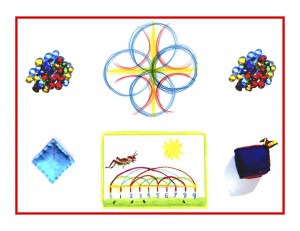Day 58
For one year, 365 days, this blog will address the Common Core Standards from the perspective of creating an alternate, ambient learning environment for math. Ambient is defined as “existing or present on all sides, an all-encompassing atmosphere.” And ambient music is defined as: “Quiet and relaxing with melodies that repeat many times.”
Why ambient? A math teaching style that’s whole and all encompassing, with themes that repeat many times through the years, is most likely to be effective and successful. Today’s post will focus a bit more on block scheduling before proceeding with Grade 1 content. As a Waldorf class teacher I loved teaching in blocks, and it was so apparent that the children did too. Attempting to teach 3, 4, or 5 subjects in one day makes for a long day and can tend to be disjointed and scattered.
One of the best aspects of block scheduling is having the afternoons free. A very favorite teaching afternoon happened in my Grade 3 class and went like this: Since gardening was a main focus, we had been keeping a worm bin, maintained by lunch scraps! One of the Grade 3 jobs was to go to each of the classrooms with a bucket after lunch and collect everyone’s compost, which was then divided between the worm bin and our compost pile. At the end of the worm sojourn, I spread large sheets of white paper on the floor and placed the worm village on it. I had everyone gather round and each tally a group of worms to see how many we had grown! Squirmy, squealy fun was had by all, and the worms were then happily ensconced in our garden beds.
This is just one example of how the homeschool or classroom environment can “get real” and take a break from worksheets and testing. Maybe this activity could be matched with a Common Core standard, I hope so. But whether you are teaching with standards or without them, the block method is optimal for efficiency, teacher-student success, and all around good learning and play.
Here are some concrete advantages:
1) A “steeping” in each subject enhances interest and can foster greater retention: Devoting 2 hours each morning for 3-4 weeks to one subject helps to deepen the connection to it and reinforces what is learned each day.
2) Provides an antidote to the hurried and scattered nature of modern life, while also helping to address ADD or other attention challenges: Learning by the clock (scheduling different subjects each day to fit into individual time slots) tends to create a rushed and harried feeling. It can be beneficial for our children who so naturally seem to operate in a more “timeless” way, to be able to relax into each subject, taking more time with it. Children with ADD symptoms will benefit, since block scheduling is more grounded and slower paced.
3/ Allows a healthy “mix” of academics, arts, and recreation within the daily, weekly, and monthly schedules: If a concentrated block is set aside for more effective learning each day, it seems easier and more manageable to schedule other lessons and activities around it.
4) It’s easier for the parent/teacher to set up scheduling and lesson plans while making sure all bases are covered: Setting up a comprehensive plan at the beginning of the year seems to be a better organizational approach, and the concentrated blocks allow for more material to be covered in less overall time.
Knowledge ensues in an environment dedicated to imaginative, creative knowing, where student and teacher alike surrender to the ensuing of that knowledge as a worthy goal. See you tomorrow for more Grade 1 fun!












